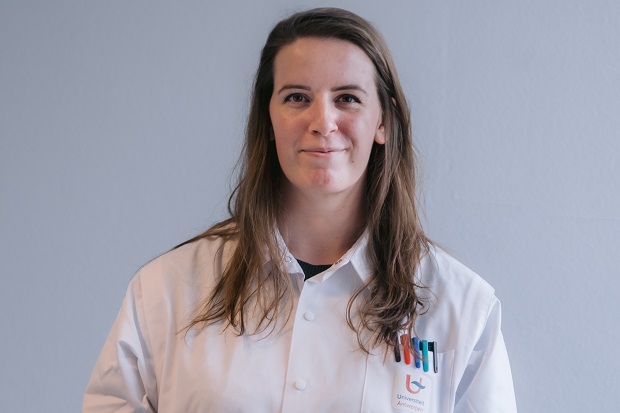- Daily & Weekly newsletters
- Buy & download The Bulletin
- Comment on our articles
Outsmarting cancer: PhD student Sophie Rovers on combining therapies to treat aggressive asbestos-induced tumours
For almost five years, Dutch PhD student Sophie Rovers has been developing novel therapeutic strategies to advance cancer treatment.
Employed as a researcher at the Center for Oncological Research (CORE), which is part of the faculty of medicine & health sciences at the University of Antwerp, she is also passionate about science communication.
Rovers (pictured, below) was awarded for the best text - by the jury and the audience - in the university’s annual PRESS>SPEAK 2025 writing competition.
Here’s her winning text about a new strategy for treating an aggressive cancer caused by asbestos.

From magic mineral to medical menace: Treating asbestos-induced cancer
As I look at the cells under the microscope, I’m struck by the irony of their existence: deadly cancer cells caused by a substance once believed to be lifesaving… Asbestos, the so-called magic mineral of the 20th century, was once used in everything from cigarette filters to surgical sutures. It was even sold as fake snow, covering Christmas trees and dusting Judy Garland in The Wizard of Oz.
But this miracle mineral left a deadly legacy. When inhaled, asbestos fibres gradually cause irreversible damage to our lungs, resulting in disease many years later. Yet shockingly, despite these well-known health risks, asbestos is still used today in over 140 countries! One of its most devastating consequences is mesothelioma, a rare and aggressive cancer that forms in the membranes around our lungs. Sadly, it’s also one of the fastest-killing cancers. Each year, over 30,000 people are diagnosed, yet only 1 in 30 survive beyond five years. With such a high mortality rate and limited treatment options, we urgently need new strategies. That’s why I’m investigating whether a combination of therapies can outperform the effects of each treatment on its own.
Tumours don’t just grow – they fight back. Like skilled soldiers, they can literally ‘improvise, adapt, overcome’ when faced with anti-cancer treatments. But we can make their battle harder by combining different therapies to attack them from multiple angles. So, my research focuses on two key defensive strategies that tumours use to hijack their environment and ensure their own survival: first, their ability to evade detection by the immune system by switching off certain immune cells, and second, their ability to form new blood vessels to fuel their growth.
The mesothelioma cells under my microscope can be injected into mice, so that I can see how this cancer behaves in conditions similar to those in humans. Remarkably, by combining two different treatments aimed at these tumour defences, I was able to slow down tumour growth considerably. The combination also extended the lifespan of the mice far beyond what either treatment could achieve on its own. While there’s still a lot of work to do before this approach reaches the clinic, these findings bring us one step closer to improving the lives of mesothelioma patients. My goal is a world where mesothelioma cells exist only under the microscope – and not in our bodies.


















